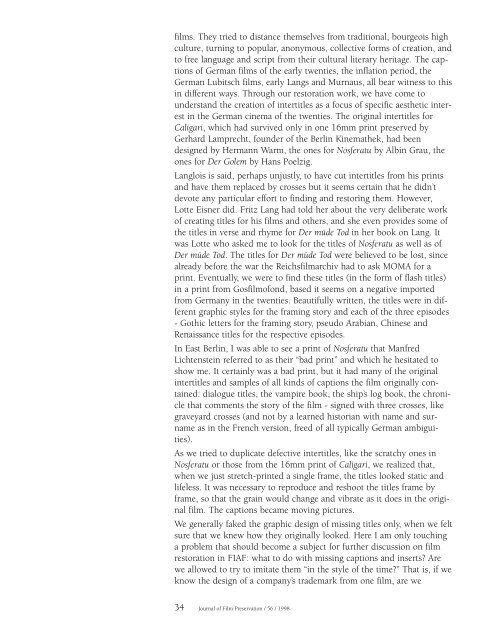Journal of Film Preservation N° 56 - FIAF
Journal of Film Preservation N° 56 - FIAF
Journal of Film Preservation N° 56 - FIAF
You also want an ePaper? Increase the reach of your titles
YUMPU automatically turns print PDFs into web optimized ePapers that Google loves.
films. They tried to distance themselves from traditional, bourgeois high<br />
culture, turning to popular, anonymous, collective forms <strong>of</strong> creation, and<br />
to free language and script from their cultural literary heritage. The captions<br />
<strong>of</strong> German films <strong>of</strong> the early twenties, the inflation period, the<br />
German Lubitsch films, early Langs and Murnaus, all bear witness to this<br />
in different ways. Through our restoration work, we have come to<br />
understand the creation <strong>of</strong> intertitles as a focus <strong>of</strong> specific aesthetic interest<br />
in the German cinema <strong>of</strong> the twenties. The original intertitles for<br />
Caligari, which had survived only in one 16mm print preserved by<br />
Gerhard Lamprecht, founder <strong>of</strong> the Berlin Kinemathek, had been<br />
designed by Hermann Warm, the ones for Nosferatu by Albin Grau, the<br />
ones for Der Golem by Hans Poelzig.<br />
Langlois is said, perhaps unjustly, to have cut intertitles from his prints<br />
and have them replaced by crosses but it seems certain that he didn’t<br />
devote any particular effort to finding and restoring them. However,<br />
Lotte Eisner did. Fritz Lang had told her about the very deliberate work<br />
<strong>of</strong> creating titles for his films and others, and she even provides some <strong>of</strong><br />
the titles in verse and rhyme for Der müde Tod in her book on Lang. It<br />
was Lotte who asked me to look for the titles <strong>of</strong> Nosferatu as well as <strong>of</strong><br />
Der müde Tod. The titles for Der müde Tod were believed to be lost, since<br />
already before the war the Reichsfilmarchiv had to ask MOMA for a<br />
print. Eventually, we were to find these titles (in the form <strong>of</strong> flash titles)<br />
in a print from Gosfilm<strong>of</strong>ond, based it seems on a negative imported<br />
from Germany in the twenties. Beautifully written, the titles were in different<br />
graphic styles for the framing story and each <strong>of</strong> the three episodes<br />
- Gothic letters for the framing story, pseudo Arabian, Chinese and<br />
Renaissance titles for the respective episodes.<br />
In East Berlin, I was able to see a print <strong>of</strong> Nosferatu that Manfred<br />
Lichtenstein referred to as their “bad print” and which he hesitated to<br />
show me. It certainly was a bad print, but it had many <strong>of</strong> the original<br />
intertitles and samples <strong>of</strong> all kinds <strong>of</strong> captions the film originally contained:<br />
dialogue titles, the vampire book, the ship’s log book, the chronicle<br />
that comments the story <strong>of</strong> the film - signed with three crosses, like<br />
graveyard crosses (and not by a learned historian with name and surname<br />
as in the French version, freed <strong>of</strong> all typically German ambiguities).<br />
As we tried to duplicate defective intertitles, like the scratchy ones in<br />
Nosferatu or those from the 16mm print <strong>of</strong> Caligari, we realized that,<br />
when we just stretch-printed a single frame, the titles looked static and<br />
lifeless. It was necessary to reproduce and reshoot the titles frame by<br />
frame, so that the grain would change and vibrate as it does in the original<br />
film. The captions became moving pictures.<br />
We generally faked the graphic design <strong>of</strong> missing titles only, when we felt<br />
sure that we knew how they originally looked. Here I am only touching<br />
a problem that should become a subject for further discussion on film<br />
restoration in <strong>FIAF</strong>: what to do with missing captions and inserts? Are<br />
we allowed to try to imitate them “in the style <strong>of</strong> the time?” That is, if we<br />
know the design <strong>of</strong> a company’s trademark from one film, are we<br />
34 <strong>Journal</strong> <strong>of</strong> <strong>Film</strong> <strong>Preservation</strong> / <strong>56</strong> / 1998

















